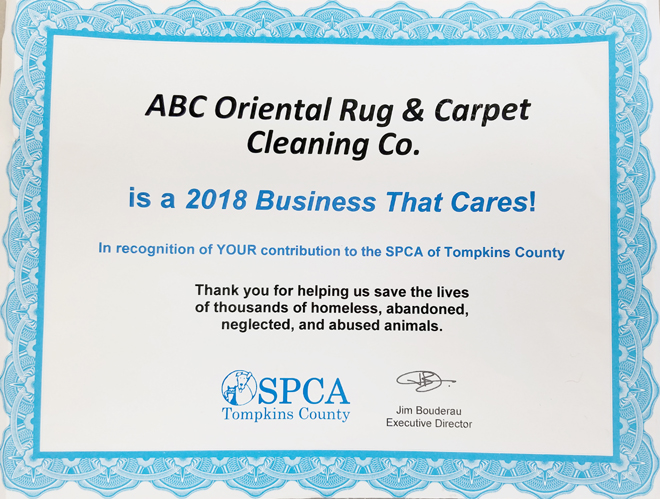ABC MONTHLY NEWSLETTER
NOVEMBER 2018
Welcome to Our Monthly Newsletter!
We hope you will enjoy this month's articles.


This month's topics are:
FOLLOW UP TO ONE TREE PLANTED.ORG
ORIENTAL RUGS
TILE & GROUT
AREA RUGS
If there is a topic you would like us to cover in one of our upcoming newsletters, please call us at
607-272-1566
or contact us by clicking here.
FOLLOW UP - ONE TREE PLANTED.ORG...
THANK YOU FOR YOUR INPUT
Thank you to all our customers who keep responding with overwhelming positive feedback to our decision to have One Tree Planted added to the list of charitable organizations we support.
From now on, we will have one tree planted for every invoice produced by our company for our customers.
OUR CORE OBJECTIVE
As we explained in September's newsletter, our core corporate objective at ABC is environmental responsibility. We care about helping to create a healthier, environmentally safer, and more sustainable world. We continually strive to provide environmentally safe cleaning care for the items in your home and business. That is why we have partnered with One Tree Planted.
ONE TREE PLANTED.ORG
One Tree Planted uses ecological reforestation to plant trees. The tree planting projects around the world are run by carefully chosen reforestation partners that understand the local environment and can be there to maintain it after the trees are planted.
OUR FIRST PROJECT
Our first project for the last quarter of this year will be planting trees in California. Over 460 thousand acres of forests were destroyed by wildfires in that state last year, killing over 230 million trees. As of this writing, the fires continue to cause massive destruction of homes and trees in California.
A WAY TO CONNECT
Because we care so much about sustainability and restoration at ABC, with One Tree Planted, we believe we have found a way to connect our small everyday actions with creating a healthier world. One Tree Planted makes it simple and straightforward for individuals and corporations to take part in sustainability issues. We are proud to be a part of their reforestation efforts around the world.
MORE INFO?
For more information, please see One Tree Planted on our website. You can browse their website at:
GREAT NEWS!
GOT QUESTIONS?
NOW YOU CAN TEXT US AT
607-272-1566
KAZAK ORIENTAL RUGS
LOCATION
Kazak oriental rugs were and still are woven in an area of the Caucasus region which is located at the border of Eastern Europe and Western Asia. The region lies between the Caspian Sea on the east, the Black Sea on the west, Iran to the south, and Russia to the north. It is divided diagonally from the northwest to the southeast by the Caucasus mountain range and is the traditional line of demarcation between the continents of Europe and Asia.
The region is one of the most culturally diverse areas of the world and is home to more than 50 ethnic groups. It is occupied by Russia, Georgia, Azerbaijan, and Armenia, as well as portions of Northwestern Iran and Northeastern Turkey. Kazak is a city in what is now the republic of Armenia.
HISTORY
Kazak oriental rugs were originally woven by Armenian weavers (generally the women of the communities) which migrated to the area in the 11th century from Turkey along with Azeri (Azerbaijani) Turk groups.
Kazak rugs are not actually associated with any particular tribe, but rather with the geographical areas in which they are woven. Most of what we recognize as Kazak is Armenian. They had a pile that featured coarse, shiny wool with many large medallions in contrasting colors.
The weaving history of the area is centuries old. However, it did not really grow until the late 1800s when an organized cottage industry was established by the government.
The most important of the Southern Caucasian rugs are the Kazak, Karabagh, Gendje, Moghan, Talish, and Shirvan. Of these, the Karabagh rugs more closely resemble Persian rugs and tend to have finer patterns. The major Northern Caucasian rugs include the Kuba, the Derbend, and the Dagestan.
As a general rule, the Southern Caucasian rugs (Kazak and others) were coarsely knotted with medium to long pile and featured large medallion motifs in their fields. The Northern Caucasian rugs (Kuba and others) had densely packed short pile woven with finely spun yarns and adorned with all over motifs in their fields.
The early Kazak oriental rugs were a sign of status for their owners. It was not unusual to find them woven with strands of silver and gold and located on floors and walls in churches and palatial homes, and even in palaces on the throne of a king or at his feet.
ANTIQUE KAZAK ORIENTAL RUGS
The Kazak rugs of the 18th and 19th centuries were produced by both Muslim and Christian communities. A large number of those produced by Christian weavers contained dates in Roman numerals.
Antique Kazak rugs made in the 19th century are very collectible and expensive. There are several sub-groups of these Kazaks including the Karachoph, Fachralo, Bordjalu, and Sewan Kazaks.
KARACHOPH KAZAK RUGS
The antique Karachoph Kazak rugs tend to be among the most valuable. They consistently featured green fields. One design featured a large, central medallion with a row or two of smaller medallions in the field at each end of the central medallion.
FACHRALO KAZAK RUGS
Fachralo Kazak rugs are another sub-group of Kazak rugs and usually featured a medallion and a Mihrab or prayer niche, suggesting they were woven as prayer rugs. The fields can include the colors of sky blue, green, and red. They tend to be almost square such as 4'x5', though large ones can be found. They have a thick pile, high quality wool, and natural dyes. The Fachralo type of Kazak tend to have quite a bit of open space between motifs.
BORDJALOU KAZAK RUGS
Bordjalou rugs have simple designs and are coarsely woven. The colors are typically a combination of blue, red, natural brown, and ivory.
SEWAN KAZAK RUGS
Sewan Kazak rugs have bold 'shield medallion' designs with scattered tribal plants growing on the background of a main red field.
LORI PAMBAK KAZAK RUGS
Another type of Kazak rug was the Lori Pambak Kazak which was produced in the Southeast Caucasus region of Southern Russia. They were finely woven and had a more closely cropped pile than some of the others. The fields were typically red and had a large medallion that can be ivory and contain stylized tulip motifs. The Lori Pambak were produced in the 5'5 wide and 8'8 long sizes.
Antique Kazak oriental rugs were almost all thick and fluffy. They were more coarsely woven than the Shirvan, Kuba, and Dagestan rugs from the Northeast Caucasus.
Kazak rugs made in the early 20th century began to add synthetic pinks and other colors. They also tend to have multiple red wool wefts (side to side cords). Many of the other types of Caucasian rugs use beige or brown wefts.
EAGLE & CLOUDBAND KAZAKS
Surprisingly, two of the most famous types of Kazak rugs, the Eagle or Sunburst Kazaks, and the Cloudband Kazaks are not truly Kazak rugs but were woven in the Karabagh region of the Caucasus.
The Eagle or Sunburst motif may have come from St. Joseph's Cross alluding to the Christian religion of the Armenian weavers.
CONSTRUCTION OF KAZAK ORIENTAL RUGS
FOUNDATION
The warps (up and down cords) were originally wool, although rugs produced today can be cotton or a wool/cotton combination. The cords are an undyed natural color, usually 3 ply, (though some can be 2 ply) with strands of different shades.
The wefts (side to side cords) can have 2 to 6 strands of 2 ply natural or dyed wool (or cotton today). The strands are usually red but sometimes yellow or blue in later rugs. Karabagh rugs from the Southern Caucasian area are similar to the Kazaks but tend to have fewer wefts (usually 2) and the wefts are undyed.
PILE
The pile is wool.
KNOT
The knot is the Turkish or Giordes symmetrical knot.
SIDES
The sides typically consist of 2 or more warp cords overcast in wool, often using pile colors or a single cord weft wrap in cotton or overcast in blue wool.
ENDS
The upper ends often will have a plain weave with fringe. The lower can have loops or a half-hitch end finish. There could also be shaggy fringes on both ends. Some use the fringe only at one end and finish off the other end by turning back the warps and hemming a few inches.
COLORS
The Kazaks used dense dyes and bright colors such as red, blue, green, and ivory.
SIZES
They were usually not larger than 5x8.
DESIGN OF
KAZAK ORIENTAL RUGS
To learn more about Kazak oriental rugs complete with photos, please continue reading here.
CERAMIC TILE
Ceramic tile is an extremely popular choice for the floors in our homes today. Whether remodeling or for new construction, hard surface flooring is almost universally chosen for the first floor while wall-to-wall carpet, if used at all, is usually reserved for the upper floors such as the bedrooms.
In this article, we go over some important guidelines about the types and sizes of the tile, installation concerns, durability, and, of course, cleaning and maintenance.
TYPES
GLAZED CERAMIC TILE
The glass coating fired onto the surface of some ceramic tiles is referred to as the glaze. This protective layer makes the tile water and stain-proof.
Note: We are talking about floor, not wall tiles. Wall tiles are not as durable and are thinner than the floor tiles. They are not meant to be used under constant foot traffic.
UNGLAZED CERAMIC TILE
This type of tile is for those people who prefer a more natural look. Unglazed tile floors will need to be periodically sealed to protect them from stains.
TERRA COTTA
Terra Cotta is red clay bisque fired at a relatively low temperature. It exhibits a very natural appearance but the tile itself is fragile.
PORCELAIN
Porcelain is made of clay which is baked at very high temperatures resulting in an extremely strong and durable product. When compared to other tiles, it is harder to cut and shape.
One advantage of Porcelain tile is it has an absorption rate of less than .5% and thus can be installed in some exterior locations where frost and freezing would normally be a problem.
INSTALLATION
Installing tile flooring is not meant for the do-it-yourself homeowner! We would highly recommend hiring an experienced professional installer for this type of time-consuming and difficult job.
As might be expected, the first and most important step in the installation is the type and condition of the sub floor it is being installed on. It is extremely important that it be completely flat, smooth, and free of any defects to avoid the occurrence of any pockets of air forming under the tiles. These will make the tiles crack and chip over time. The sub floor must also be impervious to changes in size due to changes in temperature as well.
Concrete is one of the most common sub surfaces for installations. Be aware, there is a wait time of at least 28 days after fresh concrete is poured for moisture to completely dry out of the concrete mix before the tile floor can be properly installed.
SIZES
The most common cut tile sizes are squares of 6"x 6", 12"x 12", and 16"x 16". That said, ceramic tile can actually be cut into nearly any size or shape. It is always recommended to use sizes that are evenly divisible in order to cut down on waste.
HARDNESS
The Portland Enamel Institute judges the hardness of tile on a 1 (weakest) to 5 (strongest) scale. For use in flooring applications, a hardness rating of 3 or greater is required. Less than 3 on the scale can be used only in wall applications.
DURABILITY
Ceramic tile has a lifespan of decades as long as it is properly installed and cared for.
After its useful life has ended, it may be necessary to remove it. Depending on the new flooring surface chosen, it may be possible to install the new flooring directly over the old tile floor.
CLEANING
Please continue reading here for more information about ceramic tile.
NATURAL FIBER RUGS
Natural fiber rugs offer many distinct advantages as options for floor coverings vs. synthetic fiber rugs or blends. They can bring an earthy texture, warmth, and a natural beauty, as well as a sense of relaxation and calm to our home interiors.
These rugs also speak to the desire to make a more sustainable choice for home furnishings. They can be an understatement and at the same time an elegant addition to any room.
Common natural fiber rugs include Cotton, Leather, and other animal skins, Silk, and Wool. For this article we will look at the less common ones which include Abaca, Bamboo, Coir, Hemp, Jute, Seagrass, and Sisal.
Each of the natural fiber rugs has its own pros and cons, but they are very similar in many ways as well. This can lead to a lot of confusion when it comes to making a purchase decision.
ADVANTAGES OF NATURAL FIBER RUGS
- They are relatively inexpensive.
- They can fit into almost any decorating style.
- They match well with furniture, other rugs, wall colors, and any bold colors.
- They can be layered on top of larger rugs for defining spaces under certain pieces of furniture.
- They are typically made from eco-friendly, renewable resources.
- Most are grown sustainably, requiring small quantities if any, of pesticides, herbicides or fertilizers, and they are biodegradable.
- Many of them take dyes well and many can be painted.
- Some are naturally flame retardant, anti-static, and noise dampening.
DISADVANTAGES OF NATURAL FIBER RUGS
- Some are not as soft to walk on.
- Most cannot be cleaned like area rugs made of synthetic fibers such as Nylon, Polyester, Olefin, and blends and may not clean up as well.
- Some stain easily and the stains can be very difficult to remove.
- Because they generally do not clean as well as synthetics, they may end up in a landfill sooner, cancelling out their sustainability.
- Exposure to direct, prolonged sunlight will cause most of them to fade.
- Certain rugs have a tendency to shed.
- Some are not durable enough to be in high traffic areas.
- Moisture can quickly deteriorate some of them.
- Some that are braided and sewn by hand can sprout, especially those with shorter fibers, such as Jute, Seagrass, and Sisal. (Simply use scissors to clip the fibers that have stuck out from the surface. After time, the fibers will settle and will require less cutting).
GENERAL CLEANING & MAINTENANCE OF NATURAL FIBER RUGS
SWEEP UNDERNEATH
For many of these rugs, lifting and removing dust particles from underneath should be done daily. They can also be shaken or even hung up and dusted with a tennis racket or rug beater.
VACUUM
- Regular vacuuming is important for both the cleaning and maintenance of most natural fiber rugs. It is much easier for small pieces of dirt to become entangled in these rugs than in synthetics. These small pieces can be abrasive over time and cause fiber loss.
- Vacuum with soft upholstery attachments only.
- Vacuum from several directions to remove the most debris.
- Avoid vacuuming the stitched areas if the rug has a binding.
HUMIDITY
- Maintain a consistent humidity for those natural rugs susceptible to moisture.
- Keep those rugs dry. If any areas of a rug susceptible to moisture should get wet, it is of utmost importance it be dried as soon and as completely as possible. If not, the rug may shrink and distort and the corners may curl. (If curling occurs, just dampen the curled area with a damp towel placing weights on top. Leave overnight. Repeat may be required).
- Should a rug become over wet, try rolling it up in a dry towel to remove the excess moisture. This process may have to be repeated or take the rug to a professional rug cleaner to finish the drying process.
SPOTS & SPILLS
- Attend to spots and spills as soon as possible. Always test any spotting solution in a small, inconspicuous area of the rug first.
- Always BLOT first, do not rub.
- Combine 1 teaspoon of a mild, non-bleach detergent with 1 teaspoon of white vinegar and then add 2 quarts of lukewarm water OR mix 1 teaspoon of non-bleach detergent with 1 cup of water in a spray bottle. Blot with a clean cloth.
- Oil-based or greasy stains may need a dry cleaning solvent for removal.
- Scrape off any solids with a dull knife first.
- Beer and wine spills should be blotted with a cleaning cloth. Then dampen another cloth with wood alcohol (the alcohol will evaporate quickly without over wetting).
- Spot clean borders with a mild dish soap and water solution.
STAIN PROTECTION
- It may be prudent to have your natural fiber rug treated with a stain protector to prevent permanent stains.
CHOOSE LIGHT OR DARK COLORS FOR BOUND EDGES?
- Light -colored edges easily blend into a room's decor but will show dirt more.
- Dark-colored tape hides dirt but offers limited design options.
OVERVIEW OF NATURAL FIBER RUGS
The following is a general overview of the natural fiber rugs mentioned above, each of which will be included in a series of future in-depth articles:
ABACA RUGS
To learn about the different natural fiber rugs, place continue reading here.

SPECIAL FOR NOVEMBER
*******************
IT'S THE
GIVING SEASON!
*******************
ABC is Again Partnering
with
COPS, KIDS, & TOYS
to
Help Local Families
in the Community
Celebrate Holidays.
*******************
HERE IS HOW
YOU
CAN HELP...
*******************
Bring an
Unwrapped,
Unopened,
Non-Violent,
New Toy
to our office
at
130 Cecil Malone Drive - Ithaca
EACH TOY is an Entry for a
$200 Gift Certificate
for
Any of our Services!
(The drawing will be held at the end of November)
*******************
Have Your CARPETS, UPHOLSTERY, TILE & GROUT Cleaned at Home
and
Have $20 Taken Off Your Order (above our minimum)
for EACH TOY You Donate!
(up to 3 toys maximum)
********************
CALL FOR MORE INFO
OR TO SCHEDULE TODAY!
(some services not available in all areas)
*********************
607-272-1566
*********************
THANK YOU!! WE LOOK FORWARD TO CONTINUING TO SERVE YOUR TEXTILE CLEANING AND REPAIR NEEDS!
Get New Posts Right To Your Inbox!
Get our monthly newsletter, just like this one, delivered right to your inbox each day. Just sign up and we will send you the best new articles and videos as they become available.
Your email address will NEVER be spammed, sold, or shared. You are welcome to unsubscribe at any time with the link in the email.
Top of November 2018 Newsletter
"The Cleanest Clean You've Ever Seen."
by
ABC Oriental Rug & Carpet Cleaning Co.
130 Cecil Malone Drive Ithaca, NY 14850
607-272-1566

ABC
Carpet & Rug
Spotting Guide

ABC Oriental Rug & Carpet Cleaning Co. has been family-owned and operated in Ithaca and surrounding areas for more than 48 years.
Our company is a reflection of our family name and pride.
Please Like us on Facebook!
for more information and to find out what we are doing at our business and in the community!
Stay Connected!
Links to Our Services
Allergy Cleaning
Area Rug Cleaning
Oriental Rug Cleaning
Rug Hand & Machine Repair
Upholstered Furniture Cleaning
Tile & Grout Cleaning & Sealing
We are proud sponsors of the SPCA of Tompkins CO:

Newsletter Archives

